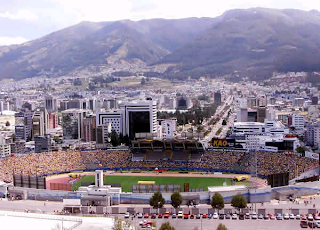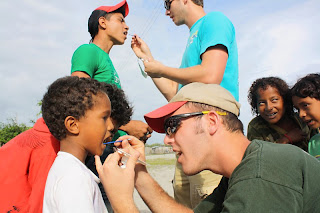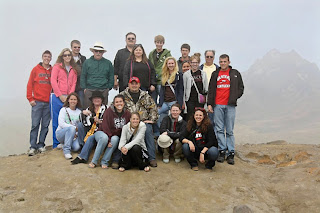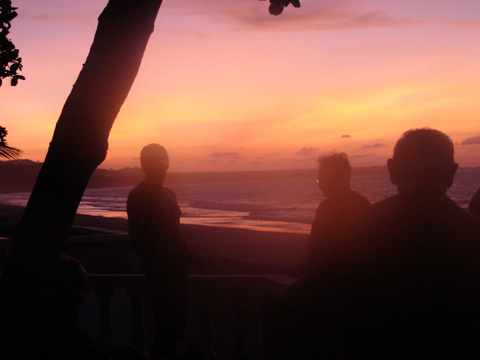Category Archives: Uncategorized
Ambato and Canoa
On Sunday, February 13, our friend Leonardo drove us to Ambato, where we had been asked to join Lexington’s Dr. Henry Vasconez and his group of about 80 doctors and nurses. Their team would be performing plastic surgeries all week, and we would be applying fluoride varnish on kid’s teeth. Also, we had planned to go to the women’s prison. (When we were here with Beau Haddock and The Highland Rim in 1996, one facet of our program and video had been a report on this prison. Unless things have changed, when a woman with small children is imprisoned here, she must bring the children with her, then depend on family and friends to feed them. We had hoped to apply fluoride varnish and provide toothbrushes and beanie babies to these women and little ones).
Canoa is a small fishing village with a great beach and waves which break perfectly for surfing, drawing a lot of gringos here. When we say small, we mean about six blocks square. It would be impossible to get lost here. There are cliffs behind the town which are used by parasailers and hanggliders. Along the beach are many great restaurants and funky bars. Our two favorites were the Costa Azul (for great shrimp, calamari and ceviche), dinner for two with drink $9.50; and La Flor, a gringo restaurant, where the bartenders are both from Michigan and one and perhaps both (we were unsure) are married to the beautiful daughters of the owner-cook. The owner and the daughters are not Norteamericanas, but we were also unsure if they are Ecuadorian. In the event, the place is very eclectic, with cool music, a great vibe, terrific food, and they disinfect all the fresh veggies, so we could actually eat everything on the plate. And, is it good! Yum. Canoa is famous for having more hammocks per capita than any other place in Ecuador, so after a hard “hammock day”, (and after having had our luncheon calamari at Costa Azul), we would escape to the caring arms of La Flor.
One night at La Flor, we met a really nice guy from, of all places, London, KY. They told us he had come down for a visit 7 years ago, and just never went home. Like many Kentuckians, he hated winter there and felt he had found paradise. Is he wrong? I think not. His name is Greg Gilliam, and he is building a beautiful new hotel right on the beach, just at the end of the town’s development. He asked us to bring him an Ale-8-One next time we visit, so that is on our agenda. Also, the bar at La Flor sells whiskeys from the U.S., including Jim Beam. I said “But, I always heard that Jim Beam drinks Makers Mark”. So he showed us the now-empty bottle of M.M., the only evidence of how popular it truly had been, so we will definitely gift them with a bottle next year. Hey, we want all these folks to jump in and help with the fluoride varnish, and we learned a long time ago, that it is wise to “grease the wheels” in Ecuador; this will be money well spent.
We met with Elizabeth Stark, who owns a hotel next to La Vista and works with the James Dean Byrd Foundation, where she places volunteers to teach English and other subjects. She arranged for us to visit the local health clinic, where we trained the local dentist to place fluoride varnish and treated several kids and adults there. We then went to a government-run day care center and treated all the kids and adults there. (Had our large supply of varnish and brushes not been lost in transit to Ambato, we’d have had much more material to work with). We also handed out beanie babies and neon-colored bracelets with “Happy Molars” printed on them (we would occasionally see these throughout the town later) and school supplies.
Leonardo came on Saturday to spend the night, so we could get an early start back on Sunday morning. After dinner, we took a drive to San Vicente and then across the longest bridge in South America, just completed last November, to Bahia de Caragues. The trip to Bahia from San Vicente used to take 1 1/2 hours, as Bahia is located on a peninsula separated by the Chone River. Bahia is one of the cleanest towns in Ecuador and in 1999 declared itself an “Eco-City” because of its efforts to promote recycling, conservation and environmental awareness. This entire area from Canoa to Bahia is not to be missed.
The next morning, after a great breakfast at La Vista, we were off again, to be thrown back into the real world. Our memories will have to sustain us until we once again, hopefully this time next year, lie in that hammock and watch the beautiful, changing colors as the sun sets again over the Pacific.
—
Rankin and Ruthi
Futbol Fever
 |
| Estadio Olimpico Atahualpa, Quito |
It was Sunday morning, and I awoke with butterflies in my stomach. One big difference in the cultures of South America and our home is that everyone here is passionate about futbol (soccer). They don’t so much like it, they seem to live for it. Leonardo, his 14-year-old son, his nephew and I had scored tickets for a playoff game for the national title between Nacional and Liga de Quito at the Estadio Olimpico Atahualpa. Even though we arrived two hours before game time, we still had to park about 2 miles away. Upon arrival at the stadium, I came to realize the fans are segregated according to their team of choice. In the end zones are the fanatics, with painted faces, everyone attired in their team colors. They have their own bands and spend the entire game dancing up and down in unison, singing and blowing whistles. It is hard to explain the excitement which accompanies a game like this; think the South African fans. As soon as we entered the stadium, we felt the electricity in the air. We arrived very early, but the stadium was already about 80% filled. By game time, there wasn’t a seat in the house. Just imagaine—the end zone gangs had everyone worked into a frenzy, and there were 45,000 screaming fans.

 The game actually started on time and right away I saw some of the best passing I had seen since the World Cup. The play was excellent and the defense was vicious. There were a total of 8 yellow cards. With 8 minutes left in the first half La Liga scored and the crowd went crazy. Of course, this got the opposing team started with the trash talk; we won’t get go into great detail about this as this blog is rated for a family audience.
The game actually started on time and right away I saw some of the best passing I had seen since the World Cup. The play was excellent and the defense was vicious. There were a total of 8 yellow cards. With 8 minutes left in the first half La Liga scored and the crowd went crazy. Of course, this got the opposing team started with the trash talk; we won’t get go into great detail about this as this blog is rated for a family audience. About ten minutes before the game ended, a swat team marched into the aisles between the two groups of fans. This is the only area of the stadium which is not surrounded by fences. The swat team shows up in full regalia—bullet-proof vests, helmets, shields and night sticks. These guys mean business! Each of the groups of fans had to exit the stadium through separate doors; then there were more cops outside to keep things calm. I have never seen such passion for futbol and felt privileged to have been to this game. I believe it was Vince Lombardi who said “Winning isn’t everything; it is the only thing”. Perhaps had he been born in most any other country on the planet, he might have been like that soccer coach in England who said (something like) “Futbol isn’t a life and death thing; it is much more important than that”.
Performance by Pianist Alex Alex Alarcón Fabre
 Tuesday, March 1, pianist Alex Alarcón Fabre performed piano works by Ecuadorian composers of the 20th century. The concert was held at Transylvania’s Carrick Theater and was made possible through the joint efforts of Transylvania University Division of Fine Arts and Kentucky Ecuador Partners.
Tuesday, March 1, pianist Alex Alarcón Fabre performed piano works by Ecuadorian composers of the 20th century. The concert was held at Transylvania’s Carrick Theater and was made possible through the joint efforts of Transylvania University Division of Fine Arts and Kentucky Ecuador Partners. He keeps an intense artistic schedule as a solo recitalist and a chamber music interpreter, and he adds to his credits a significant number of vocal recitals accompanying some of most upcoming singers of Ecuador. Alarcon has played in the most prestigious concert halls around his country, and has participated in many national and international music festivals.
He keeps an intense artistic schedule as a solo recitalist and a chamber music interpreter, and he adds to his credits a significant number of vocal recitals accompanying some of most upcoming singers of Ecuador. Alarcon has played in the most prestigious concert halls around his country, and has participated in many national and international music festivals.A Date to Remember
Kentucky Ecuador Partners will sponsor a Dutch Dinner in honor of Alex Alarcon on Tuesday, March 8 from 6:00 to 8:00 pm at the Village Host Pizza, 431 East Vine in Lexington.
Apartamentos Panoramico: Home Base in Quito
Another Successful Study Abroad to the Coast of Ecuador
 |
| Kristie Guffey was applying the dental sealant on a young boy in the coastal village school. |
A group of students traveled to Ecuador during the winter session on an agricultural study abroad experience. There were 18 students traveling along with Dr. David Coffey, Dr. Melissa Stewart, Kristie Guffey and a dentist from Winchester, Kentucky.
 |
| Agriculture freshman, Josh Dennis and Junior, Andrew Peden applying dental sealant. |
 |
| The entire WKU agricultural group 14,000’ high in the Andes Mountains. |
Pre-Pharmacy major, Lashelle Courtney wrapped up our trip with these words, “To see mountains that touch the clouds, to witness farms and plantations of bamboo, bananas and palm oil, to be indulged into lifestyles that are new and different from our own, to touch peoples´ lives and have them touch ours right back, the study abroad trip to Ecuador was the trip of a lifetime.”
By: Kristie B. Guffey
Ibarra
Today found us returning to Ibarra to visit friends and continue our dental program, which was started in 2002. On our way out of Quito, as we were driving through the Guapalo neighborhood, I thought once again what a beautiful town this really is. The winding streets through this hill town really resemble villages we have seen in Spain. Upon leaving Quito, you travel through mountains that are dry and much like areas of Africa. After reaching the town of Cayambe, the terrain turns lush and green. The patchwork farms on the sides of the mountains are a lovely site. One thing that strikes everyone as they travel through this part of Ecuador is that fields are planted on the vertical slopes of the Andes. The area is well-known for fresh blackberries and strawberries. A great blackberry syrup, called arrope de mora, is made here, and is awesome on pancakes.
In the several years since he was in Kentucky, Nicolas has created monumental sculptures which have been placed in the central parks of the towns of San Gabrial and Gitan in Carchi Province. He has been very successful and now has expanded his cultural center to increase his exhibition space by 120% and also is including a cafe, which Soly will manage.
As you leave Esperanza and climb the mountain, you drive through stunning scenery, including eucalyptus forests and a patchwork of planted fields. You realize you have entered a world all its own as everyone here is indigenous. The type of bus these folks have to use is exactly what we are riding in, a truck with sides on the bed. The difference is, in their trucks, there might be 15 or more people. Everyone here still wears their native clothing and don’t seem to be affected by outside culture.( At one point on our way back down the mountain that morning, we came around a curve and realized we were following a pickup truck carrying a somewhat small casket along with one of the deceased’s family members, surrounded by funeral flowers and leading about 8 other mourners).
Cuenca
No trip to Ecuador is truly complete without a visit to our favorite city, Cuenca. The flight there is the coolest because you fly right down an avenue of volcanoes. The plane flies so closely over some of them that you feel as though you could reach right out and touch them, or better yet, see into them. Cuenca is 275 miles south of Quito and is Ecuador’s 3rd largest city. It has cobblestone streets and various colonial-era churches, plazas and buildings. UNESCO declared it a World Heritage Site since much of the city’s colonial architecture remains intact. Cuenca was the 2nd largest city in the Inca empire, after Cusco in Peru. The foundations of the former Inca palaces became foundations for the city’s churches and government buildings. Before the Incas (1400’s) the Cañari people had lived here for centuries. They were the first inhabitants of Cuenca, building a city here around A.D. 500, called Guapondeleg. After the Incas conquered them in 1480, the city became Tomebamba, the name of one of the rivers which run through the city. Pizzaro and the Spanish conquered the Incas in 1534, and the city of Santa Ana de los Cuarto Rios de Cuenca was founded in 1557.
As we continued on our way, we saw a huge mountain towering over everything around it and going straight up. We soon came to realize the ruins were to be found on this mountain. As we pulled off the main road, we hit what is best described as a goat path. After about 1/2 mile, it got better, then turned into a great road. As we ascended, the view became more and more dramatic. Finally we reached the small community of Cojitambo and asked directions. We were told to keep on going to the very top. The higher we ascended, the less oxygen there was, and the car started coughing and sputtering. Finally, with the car now in first gear, it could climb no further. So we got out and started our climb. We stopped often, first to catch our breath, and second to become yet more breathless by the fantastic view. We were at the highest spot in the entire area and the world was there at our feet. We finally reached the peak of the ruins, with a 360 degree panorama. To the south we could see the entire city of Cuenca, to the east the town of Azogues, to the west the way to the coast, and to the north, Cajas (The Boxes), a national park with over 20,000 lakes. (Yes, that is the correct number. Cajas is a story all its own, but will have to wait for another year). The person in our group who was the most blown away was our driver. He was amazed by the entire experience and loved the fresh air. Cojitambo was built by the Cañari as a defensive fort. They could
see for about a hundred miles in any direction, so it was impossible to sneak up on them.We spent a while hiking around and enjoying the view. There are few places left in the world which give a sense of wonder. This place seemed to us to be very spiritual as well as being physically stunning. If there is any place everyone needs to visit in Ecuador (before it is discovered by too many tourists) this is it. We had the place to ourselves. It definitely is not on the tourist radar yet, as no one in Cuenca seemed to have heard of it. Good. Best kept secret.
Quito
January 19
Quito—After an uneventful trip back from the coast to Quito, the college group and the Skinners, (minus Ruthi, gone to get a decent haircut, and having been on this cool trip before), met to take a ride on El Teleferico. This great cable car was constructed by the Swiss a few years ago. It is a 6-person car which takes folks up the side of the volcano Pichinca which tops out at13,287 ft. It takes about 10 minutes to reach the top at 3,286 ft. and it is really interesting to see the vegetation change as higher altitudes are reached. There was a great view of Cayambe and several other volcanoes, all snow-covered (something the folks back home may be unable to fully appreciate during this horrible winter of ’11). At the top, Quito lies before you, surrounded by a line of some 7 volcanoes, simply breathtaking. It makes your heart beat faster in amazement; or it could possibly have been that altitude, us having started the journey at about 10,000 ft! There are many hiking trails which give different perspectives of the city view, as well as horses for rent for those who don’t dig on high-altitude hiking. It is so spectacular, you consider never leaving, until the cold starts to seep into your very marrow. If you are ever in Quito, Ecuador, Sud America, this is a treat not to be missed!





